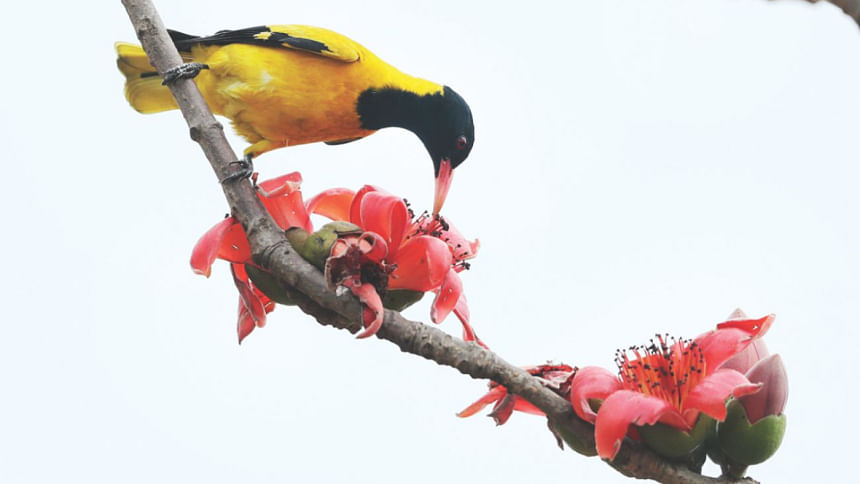Shimul

After a short and mild winter, spring is in the air. Nowhere is it more evident than in the flowers that are blooming. Among wildflowers, you can see bhat (hill glory bower) and akond (crown flower) blooming in the fields. In larger trees, my favourites are mandaar (coral flower), polash (parrot tree), kanchon (bauhinia) and the beautiful shimul (silk cottonwood.)
In the countryside, shimul is a treat for the eyes. That's because the deciduous tree has shed its leaves during winter, and the bold red flowers that have appeared ahead of new leaves envelope its crown and visible without obstruction. The tree stands out against other trees and is easily spotted from country roads. The flowers are large (about 6” across) and have soft, thick petals, five per flower, with an oily sheen. While red is the common colour, I have also seen trees of yellow and white shimul flowers.
The shimul is a straight, tall tree that can grow up to 20 meters tall. Its trunk is covered by thorns. The leaves grow in a pattern resembling the fingers of an outstretched palm. Its few branches spread in a circle around the trunk. A robust and resilient tree, it can grow in many types of tropical environments and soils. Its seed pods ripen in the summer and, if left unpicked, burst yielding fluffy cotton and tiny black seeds. The tree's sap, as well as roots of juvenile trees, have medicinal uses.
The wood of the shimul is soft, whitish and lightweight, reminiscent of balsa wood that is often used by children to carve into toys. In fact, the shimul (bombax ceiba) shares the same genus as the balsa tree (bombax pyramidale.)
But for me the shimul tree also has another draw. Its flowers attract birds. There are several ways that birds benefit from the shimul flower. They contain nectar that birds like to drink. Some birds also eat the petals. Finally the insects that come to the flowers are also eaten by many birds.
Indeed, it is a joy to stand under a blooming shimul tree and watch the birds. I spent one morning doing just that in Purbachol as a variety of birds made their way through the tree. First came the kath shaliks (chestnut-tailed starlings) with their inquisitive eyes and blue-yellow beaks. They hopped from branch to branch, systematically scouring the flowers for food. Also present were jhuti shaliks and bhat shaliks – jungle myna and common myna – which were much larger than the starling but less thorough in their search. They looked in only a few large flower clusters, flying rather than hopping between branches. The bulbulis (red-vented bulbul) made short forays in and out of the tree, but did not appear to score well.
The highlight came when a holud pakhi (black-hooded oriole) flew over in search of food. This is one of our most beautiful birds with a bright yellow body, pink beak, black head, and a beautiful whistle for a song. It inserted its head completely inside each flower while searching or eating. Defying gravity, effortlessly jumped up or down branches after it finished with a flower. It also aggressively buzzed away any bird that appeared as competition. Its yellow colour added a startling contrast to the red flowers.
While winter's migrant birds disappear until the next season, flowers such as shimul give us an opportunity to observe and appreciate our beautiful year-round birds.
facebook.com/tangents.ikabir

 For all latest news, follow The Daily Star's Google News channel.
For all latest news, follow The Daily Star's Google News channel. 



Comments